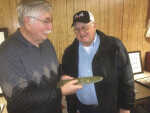Dig it: Archaeologist speaks

Jim Feagins became infatuated with antiquity growing up on his family farm near Harding in northern Bourbon County. He would find bits and pieces of stone articles from people who had occupied the land well before his family.
"What drew this (ancient) people to this area? The more I learned over the years, I learned I needed to know more," he told a crowd of about 35 people at Uniontown's City Hall on Thursday.
Feagins, who now lives in Belton, Mo., does archeological consulting and cultural resource management.
He was invited to speak as a part of the annual Watershed District No. 102 meeting by Bob Love, district treasurer and a former classmate of Feagins.
Feagins had been a part of the team that determined there were significant historical sites involved in the new watershed lakes and ponds being proposed by the district.
He spoke extensively on an archeological dig on the Jim and Dennis Meech property site, along the Little Osage River in northern Bourbon County.
"Jim and Dennis Meech were kind enough to lay aside the land for a season," Feagins said. This was following a flood along the Little Osage River in 1995.
He found that several different groups of people had previously decided to live on that site.
"I began to notice artifacts, certain styles of artifacts, several different styles. At least two time periods. There were the Cuesta folks, from 400 to 600-800 A.D. They built big houses with sturdy timbers. The were late pre-historic."
The Bourbon Complex people were also found to have lived at the Meech site, near the Little Osage River.
"The Bourbon Complex people were from 1400 to 1500 A.D., estimated. They were hunting groups ... related to the Wichita Tribe."
"There were lots of scrapers, they were working hides; deer and bison, we speculate."
Many volunteers have helped him on his digs and he has indexed and reported on 450 sites. Any significant items are sent to the Kansas State Historical Society.
Articles are mapped on a grid system and forms are filled out. "It's intensive, it takes a long time," he said. "It takes a lot more time to do the writing. The field work is a small part of the time."
